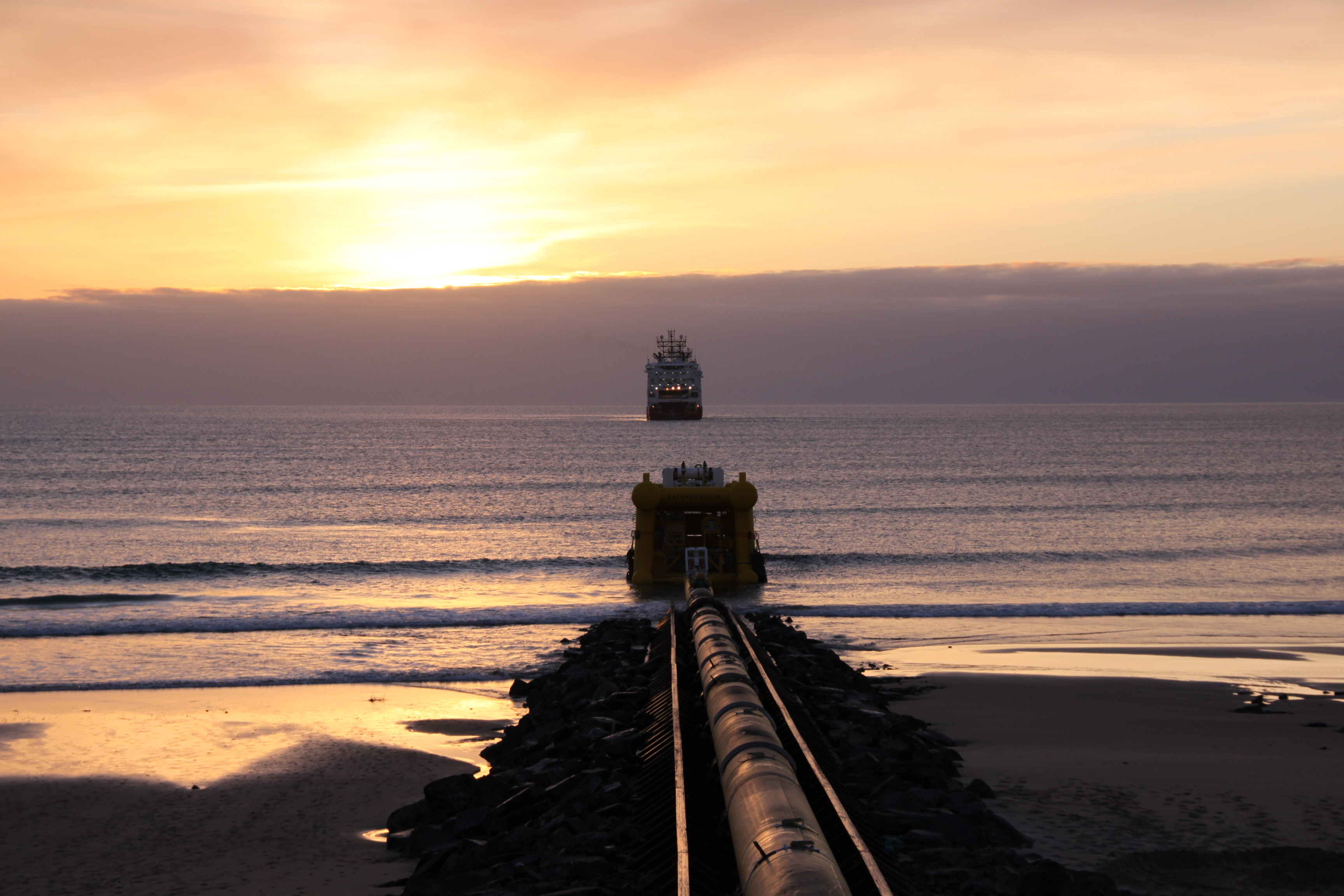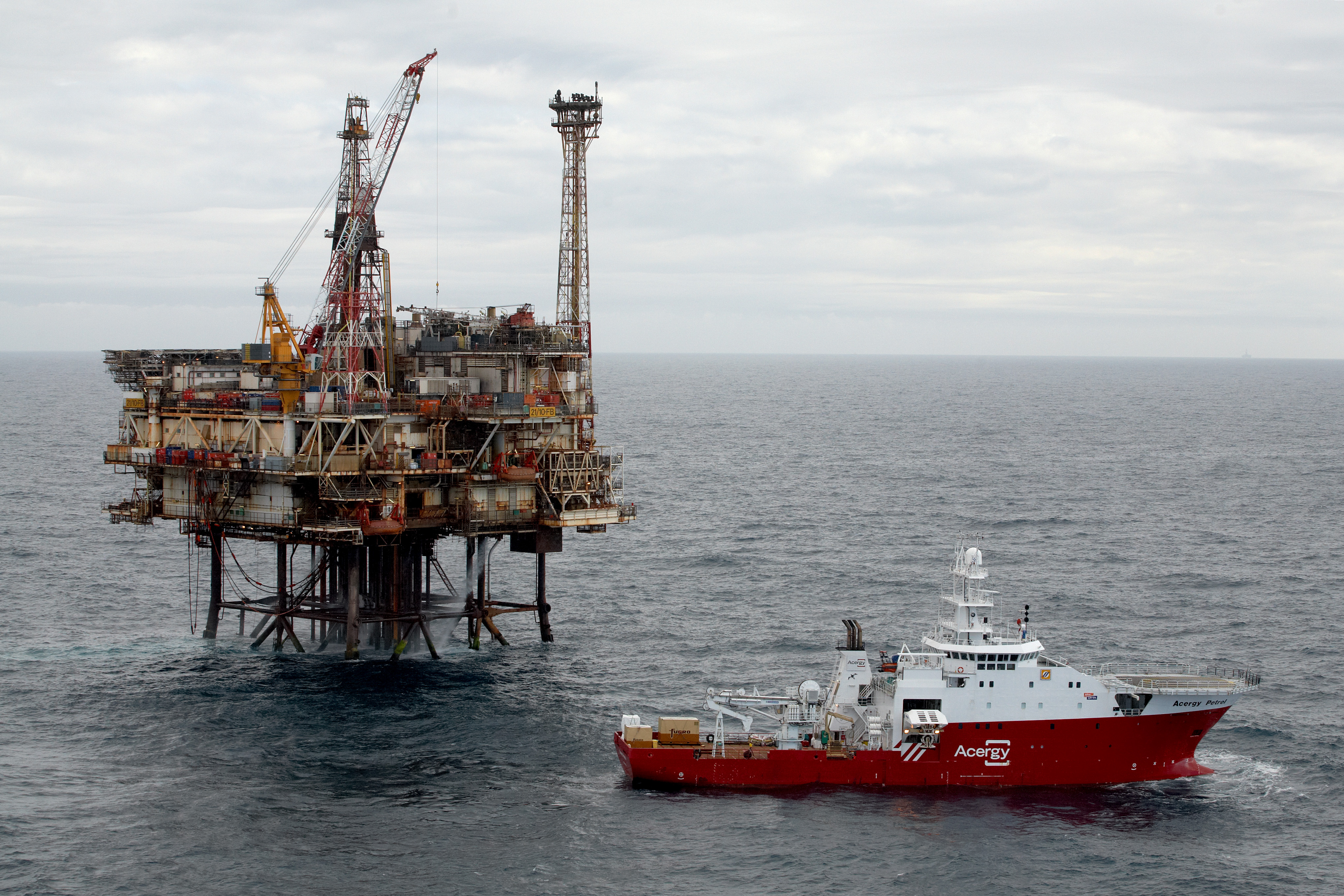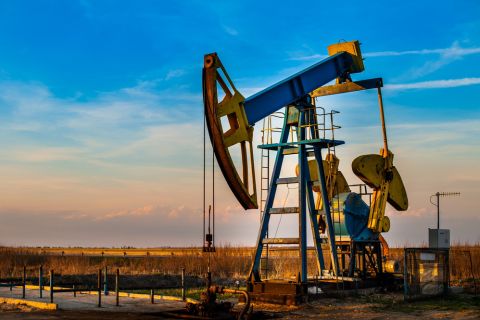Apache has invested consistently in the Forties Field’s subsea infrastructure since taking over the reins from BP to help build up and then maintain the project’s production efficiency and output.
With the original field development featuring five platforms—Alpha, Bravo, Charlie, Delta and, a little later, Echo—these production facilities lie in water depths ranging between 95 m and 128 m (312 ft and 420 ft), with the Forties Alpha Satellite platform only installed in 2013.
Just to recap, Forties Alpha, Charlie and Delta are self-contained drilling, production and processing units, while Bravo is no longer processing fluids but is directly exporting them to Charlie for processing. Echo has no processing facilities and exports its production fluids for processing via the Alpha platform.
Underneath the waves the field also features 14 pipelines and more than 60 caissons in total, with the Forties Charlie platform acting as the gathering platform for the entire field. It is connected to Alpha by a 20-in.-diameter submarine pipeline, to Bravo by a 14-in. multiphase production pipeline and to Delta by an 8-in. flexible pipeline.
Processed fluids are then exported onward from Forties Charlie to the Scottish coastline at Cruden Bay, and then further on to the Kinneil processing facility via the BP-operated Forties pipeline system.

The Bacchus subsea tieback bundle tow head being launched from the beach in Wick, Scotland in 2011 is shown. Three subsea production wells were tied back to the Forties Alpha platform via the 6.8-km subsea pipeline bundle, with first oil flowing in April 2012. In 2016 the first well is due to be converted to a water injector. (Photos courtesy of Apache Corp.)
Dramatic change
Patrick Duggan, Apache’s subsea projects and operations manager, points out that since Apache took over the field in 2003 (with estimated remaining recoverable reserves then put at 140 MMbbl) the picture has changed dramatically. With about 240 MMbbl produced so far, 120 MMbbl of it coming from Apache-drilled wells, it is clear that the company’s substantial investments have transformed the field’s future compared to just 12 years ago when the asset was essentially being wound down.
“We have produced what BP thought was there, and we have proven more than it thought was there,” Duggan said. “One of the key things that Apache identified was that with positive capital investment on maintenance and upkeep, uptime and availability could be greatly improved.”
Apache has invested billions of dollars throughout the entire Forties Field, both above and below water, to keep the assets viable and efficient. It has been rewarded by production levels that have risen from initially around the 40,000-bbl/d level to at one point as much as 80,000 bbl/d. It is currently still averaging about 50,000 bbl/d.
“That increase in production really stems from produced water reinjection, a power and gas ring main being installed, and a pipeline replacement that made all these systems available on a longer timescale, which kept efficiencies up,” Duggan said.
Apache’s typical availability and productivity now ranges from 89% to 91% against a North Sea average of about 60%.
Water-injection pumps
Produced water-reinjection pumps were put in to manage and maintain pressures in the reservoirs. To ensure that all five platforms are reliably supplied with gas and electricity, Apache installed the innovative subsea power and gas ring main in 2004.
Natural gas production in the field is limited to certain areas so Apache installed the ring main to tie the four main platforms together. Fiber-optic cabling also was installed.
The system provided the foundation for much of what has followed by giving Apache the ability to convert its power generation to gas and to increase the generating capacity to provide the power required to install and drive modern electric-powered pumps and cranes, both of which have helped to further reduce emissions as well as aid operations.
“One of the key subsea elements was the installation of the power and gas supply ring main between the assets,” Duggan said. “Two out of the five platforms had main power generation, and it meant that in times of fluctuating supply and demand they could export power to the other assets in the field. It was about keeping that redundancy and uptime as high as possible. If one generator goes down, the other can supply,” he said.
ICCP installed
Duggan also highlighted the impressed current cathodic protection (ICCP) system installed in 2009 on Alpha, Bravo, Charlie and Delta as another important development in helping to prolong the life of the field.
Two independent studies were conducted to determine the estimated current requirement to protect the Forties structures and
to enable a retrofit cathodic protection system design to be produced. The selected cathodic protection system was a retrofit ICCP system, which provided the most cost-effective solution for the provision of additional current capacity for the offshore platforms’ cathodic protection system.
“That was installed in 2009 on the four main jackets and was primarily fitted because the assets were put in quite some time ago on a 25-year design life,” Duggan added. “The original sacrificial cathodic protection systems were well beyond their design life. Before they became nonoperational, the decision was taken to put in the ICCP system to continue to cathodically protect the assets from a structural integrity point of view.”
The same year Apache also replaced the existing interplatform oil export line PL56, which transports processed oil spiked with condensates from the Delta platform to Forties Charlie. The existing 20-in. flowline was replaced by a flexible 8-in. flowline (PL2570). As part of this upgrade both the Forties Charlie and Delta platforms had new topsides elements installed. The Forties Charlie platform also had a new pig receiver installed.
Retrofitted SSIV
Further highlighting Apache’s commitment to safety, in July 2014 the company retrofitted a subsea isolation valve (SSIV) on the Cruden Bay 36-in. pipeline by removing the existing spools in place.
The retrofitted system for the 36-in. pipeline consists of the SSIV structure, seven tie-in spools and a control umbilical that provides control and power to the SSIV. The SSIV system enables if necessary, and with suitable platform controls, the isolation of the Forties Charlie platform from the 36-in. MOL Export pipeline.
“The SSIV retrofit project is part of Apache’s commitment to safety,” Duggan said. It was identified that there was a real benefit in putting in an SSIV to give an additional level of protection. The Forties Charlie platform is one of the key gathering stations for the Forties pipeline system. Our key priority is protecting our personnel and our assets, and last summer we commissioned the 36-in. SSIV.”
To maintain the integrity of the subsea assets, inspections are carried out on a regular basis.
“Fugro is our preferred inspection contractor, so with ROV support vessels they have done quite an intensive inspection program at the Forties Field on the jacket structures themselves and the associated pipelines,” Duggan said. “Inspections are typically done every two or three years.”
In 2014 Apache retrofitted an SSIV system on the Cruden Bay pipeline, a system that enables if necessary the isolation of the Forties Charlie gathering platform from the 36-in. main oil export pipeline, for an additional level of protection.
Standardized subsea approach
With Apache’s proactive pursuit of new oil and gas accumulations in the Forties area, it has had to stay one step ahead of the game, including employing a standardized approach to subsea developments.
“One of the main things Apache did and continues to do is to concentrate on drilling to keep these repeat smaller targets producing hydrocarbons over the asset, which is all about cash flow and keeping them viable,” Duggan said. “To keep the assets operational, one of the key things has been seismic. A lot was reshot, including the use of 4-D seismic, and a number of newer targets were identified. Apache looked at some of these perceived uneconomical targets and realized that they could be produced if done in the correct manner.”
Duggan also added that the way Apache manages projects “is to obtain a ‘fit-for-purpose’ design. We look to the industry, which manufactures kit to hugely specialized guidelines, and we look at existing designs and make them suitable to our requirements. Typically our projects come in more cost-effectively and quicker. Rate of return on investment is more attractive—quicker and cheaper.”
Apache looks to the industry to supply and support equipment that meets its requirements and takes more off-the-shelf designs, he said. “The industry is starting to align with Apache and realizes that it does work and is more cost effective,” he added.
Satellite tiebacks
Those subsea tieback satellites brought onstream in this manner include the Maule, Tonto and Bacchus fields.
The development plan for the Bacchus oil field was sanctioned by the U.K. Department of Energy and Climate Control in June 2010. The project comprised three subsea production wells tied back to the Forties Alpha platform via a 6.8-km (4.2-mile), 40.5-in. subsea pipeline bundle. The bundle contained two 6-in. piggable production lines, two 4-in. produced water-reinjection/heating lines, a gas-lift line, scale squeeze, methanol pipelines, hydraulic lines, future chemicals and power/signal cabling.
The bundle, manufactured by Subsea 7, was installed in 2011 after being launched from the beach in Wick, Scotland. The subsea control system incorporates a hydraulic power unit and a master control station to the topsides.
The topsides modifications for the Bacchus project included piping systems, pig traps, a high-integrity pressure protection system, multiphase flowmeter, methanol and biocide packages, and controls, fire and gas upgrades.
First oil from Bacchus was achieved in April 2012, with the second well completed and subsea tie-ins finished in July 2012. In July 2013 the third well was drilled and subsea tie-ins were completed with first oil also flowing. In 2016 the first well will be converted to water injection.
Impressively, Bacchus was developed subsea at a cost of $22 million per well slot, a figure substantially lower than what most North Sea operators could achieve.
Also in 2013 Apache brought the Tonto Field onstream via the deviated Tonto-1 well, drilled from the Forties Bravo platform. The well also taps into the Eocene-aged Brimmond reservoir above the main Forties reservoir.

Apache has 14 infield pipelines to take care of on the Forties development. The Acergy Petrel is pictured alongside the Forties Bravo platform undertaking pipeline survey and inspection works.
Aviat advances
A current project ongoing for the Forties team is the development of the Aviat gas field. Aviat is a shallow, low-pressure, low-temperature gas reservoir (traditionally seen as a drilling hazard) located about 23 km (14 miles) to the east of the Forties Alpha platform in Block 22/07.
The objective of the field development is to produce gas to the Forties Alpha platform for use as fuel on the Forties Alpha main and satellite platforms as well as the Charlie and Forties Delta platforms via the power and gas ring main.
“The plan is that gas from Aviat will be used in the field and is not primarily for export. It minimizes the need to import gas and will dramatically reduce the amount of diesel that needs to be imported and bunkered. We still have the diesel generators for backup demand, however. By producing Aviat more than 15 years, it will help to keep these older assets viable by minimizing the actual operating costs,” Duggan said.
The pipelay vessel Lewek Express carried out the spooling of the main 23-km pipeline, and the manifold structure and controls umbilical also were installed as part of a four-week campaign. That work was carried out in third-quarter 2015, with the tie-ins of the Forties Alpha jacket then taking place.
Securing the future
The plan is for two wells to be drilled on Aviat starting in second-quarter 2016 or third-quarter 2016, finishing by around August 2016, with first gas to follow soon after. FEED was completed in February 2015 for Aviat, with detailed design and engineering wrapping up in September 2015.
Other related work has seen 12-in. and 20-in. bellmouths installed in July 2015, with mattress crossing installation also taking place, along with pipeline welding and fabrication. A total of 1,892 welds were completed.
The installation of the 23-km, 8-in. pipeline, 23-km controls umbilical, flexible riser, SSIV and manifold structures began in September 2015, with pipeline pig cleaning, gauging and conditioning also taking place.
When the Aviat Field does come onstream later in 2016, it will be yet another example of Apache thinking a little differently than everyone else to keep Forties pumping. “It’s all about securing the future of the assets,” Duggan said.
Different approach
Apache’s North Sea projects group manager, Mark Richardson, highlighted a subsea example of exactly how the company has approached things from a different angle.
The operator had a requirement for a retrofit subsea choke valve, with installation required by December 2015, with a given valve lead time of 22 weeks.
The traditional contractors approach saw Apache eventually receive a proposal for a 7-m by 7-m (23-ft by 23-ft) over-trawlable structure with a planned delivery date some eight weeks after the specified date. It also came with a required installation sea state of 1.2 m (4 ft) and the use of a metrology spool. The engineering quote was $174,000 with a fabrication cost of $732,000.
Apache, looking to move faster than this, decided this was not acceptable and went back to the market seeking a new approach. The end result was that it then received and proceeded with a fit-for-purpose solution from another provider delivered by its original specified date that also was able to handle installation in a sea state of up to 3 m (10 ft) and with no metrology spool.
The end result? An engineering cost of $45,000 and a fabrication cost of $75,000. “Technology has its place, but currently it’s not the whole answer,” Richardson said. “It’s about how we do things.”
Recommended Reading
Texas LNG Export Plant Signs Additional Offtake Deal With EQT
2024-04-23 - Glenfarne Group LLC's proposed Texas LNG export plant in Brownsville has signed an additional tolling agreement with EQT Corp. to provide natural gas liquefaction services of an additional 1.5 mtpa over 20 years.
US Refiners to Face Tighter Heavy Spreads this Summer TPH
2024-04-22 - Tudor, Pickering, Holt and Co. (TPH) expects fairly tight heavy crude discounts in the U.S. this summer and beyond owing to lower imports of Canadian, Mexican and Venezuelan crudes.
What's Affecting Oil Prices This Week? (April 22, 2024)
2024-04-22 - Stratas Advisors predict that despite geopolitical tensions, the oil supply will not be disrupted, even with the U.S. House of Representatives inserting sanctions on Iran’s oil exports.
Association: Monthly Texas Upstream Jobs Show Most Growth in Decade
2024-04-22 - Since the COVID-19 pandemic, the oil and gas industry has added 39,500 upstream jobs in Texas, with take home pay averaging $124,000 in 2023.
What's Affecting Oil Prices This Week? (Feb. 5, 2024)
2024-02-05 - Stratas Advisors says the U.S.’ response (so far) to the recent attack on U.S. troops has been measured without direct confrontation of Iran, which reduces the possibility of oil flows being disrupted.




